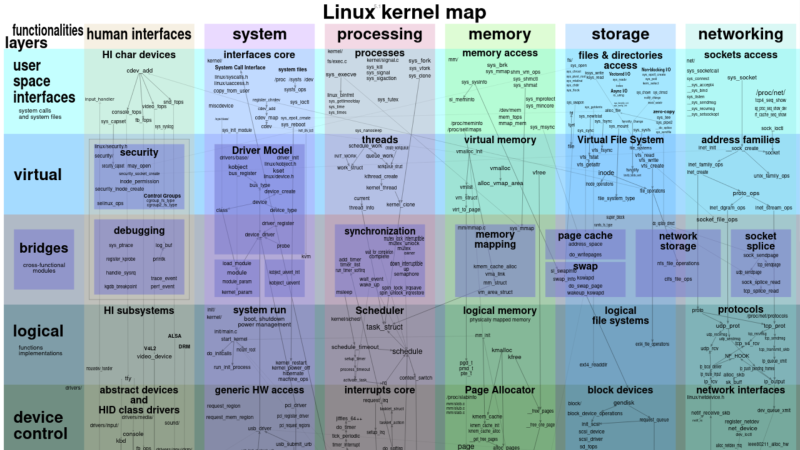Linux has become one of the largest operating systems on the servers that run large websites, and hopefully, one day, it will be big in the desktop market too. Some of you may know how Linux as an operating system is structured, but have you ever wondered how the kernel itself is structured? Maybe you’ll find this colorful interactive map of the Linux kernel by [Costa Shulyupin] useful.
The interactive map depicts the major levels of abstraction and functionalities, dotted with over 400 prominent functions from the Linux kernel, which are also links to a cross-reference site so you can see all the definitions and usages. It divides the kernel into 7 rows and 7 columns containing domains with well-known terms like security and debugging, but also more obscure things like block devices and address families. These are also links, this time to the definition of the term in question. Finally, there are arrows flying everywhere, to show the relationships between all the many functions in the kernel.
Now, the great number of arrows is certainly impressive, but to some people, the word “kernel” means nothing. Typically, the kernel is the supervisor in an operating system: programs request resources like memory, files and processing time from the kernel, which decides whether the requests are permitted and how much of a resource to give.
This is a bit on the theoretical side. If you want something “practical”, how about running Linux on a Commodore 64?
















“.. and hopefully, one day, it will be big in the desktop market too.”
I hope not.
Care to elaborate?
He’s a gatekeeper
Indeed. I totally understand him, I don’t want Linux for the masses either, it’s too precious.
They need to add personal/private A.I. to Linux.
“I want it big enough to run the stuff I need, but absolutely no bigger, to keep the n00bs out.”
It only gets bigger if we can’t please the n00bs efficiently. They need cat pictures and Steam. I think we can get it done without too much refactoring.
I see it. What are you talking about?
This is so cool! Thanks for the article and Thanks to the maker.
In the next version a want a visiolation what happend after i startet linux, like an animation.
And after that i want to upload errors to see where the mistake is. Like after new updates.
After the update problems with linux mint, i switched to debian these year.
I had no update problems. What are these update problems you speak of?
For us to complain “Not a Hack!!1!”, “Not news, I saw that 3 days ago!!1!” or “That’s lame, I could do it with a 555 and some duct tape”.
And that’s good ’nuff for me :)
It’s right there…